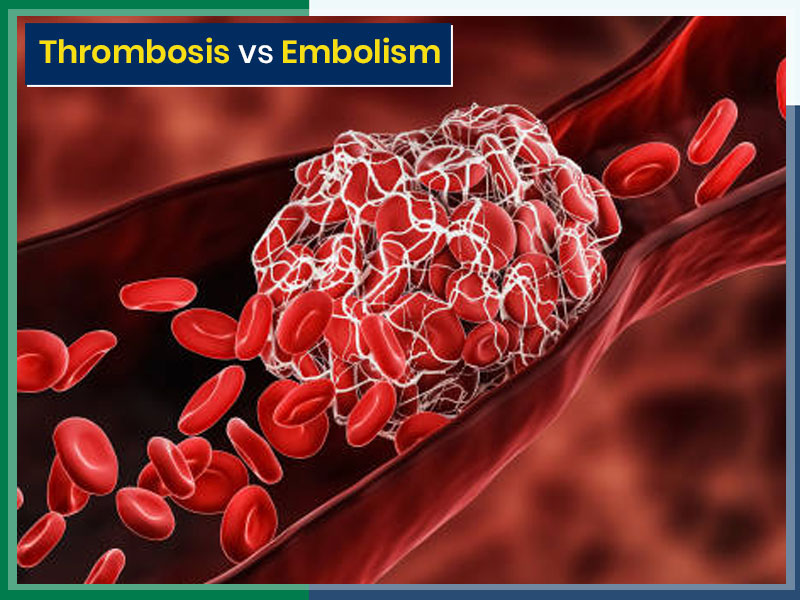
We all know that the human body has its defense mechanisms to protect itself from foreign invaders. One such line of defense is blood clotting, which is a common way of protection in case of an injured blood vessel. In normal circumstances, the formation of blood clots is a good thing. It helps in healing. But, what happens if this goes wrong? Thrombosis, as per the National Health Portal of India (NHP), is the formation of a clot in an artery or vein. This can obstruct the blood flow and can detach and lodge into other organs, causing serious implications.
Table of Content:-
To raise awareness on this issue, World Thrombosis Day is observed on October 13 every year. It is celebrated on this day to commemorate the birth anniversary of Rudolf Virchow, the 19th-century German physician, biologist, pathologist, and anthropologist, who developed the concept of thrombosis. Similar to thrombosis, embolism, which is another medical condition, also involves the obstruction of blood flow due to a blockage caused by a foreign object. On the surface, these two might appear similar but are two distinct medical conditions with underlying differences. To understand the difference between the two, Onlymyhealth spoke to Dr Bhavesh Arun Popat, Vascular & Interventional Radiologist, Endovascular Clinic, Mumbai. Here is what he said:
Difference between Thrombosis & Embolism

(Photo Credit: Freepik)
When a blood clot develops in a spot where it shouldn’t have, it is called a thrombus, and the spot is called thrombosis. Once formed, this blood clot can travel through the body and can even lodge into an organ. On the other hand, an embolism is when a blood clot or any foreign object gets stuck and severely obstructs the blood flow. The foreign object is called an embolus.
As per studies, both thrombosis and embolism are therapeutically silent, which means these are asymptomatic, hence, are difficult to diagnose. But knowledge regarding the symptoms can ensure timely intervention, thus preventing any serious consequences. Any delay can raise concerns regarding the heart, lungs, brain, and other parts of the body.
Thrombosis: Types
It is of two types:
-
Venous Thrombosis (VTE): It is when a blood clot forms in the deep veins of the lower leg or thighs. This clot can move to any part of the body along with the blood flow. When this makes its way to the lungs, it is called pulmonary embolism (PE), which is a concerning issue.
- Arterial Thrombosis: A serious health condition, in the case of arterial thrombosis, a blood clot forms in an artery, obstructing the flow of blood through the body. This can result in severe conditions such as heart attack, chest pain, brain stroke, etc.
Also read: Thrombosis Myths debunked: 5 Things About DVT That People Believe But Aren’t True
Symptoms Of Thrombosis
A person with thrombosis can experience the following symptoms:
- Blood clot or swelling in arms or legs. This can cause increased warmth, aches, and cramps just by slight touch.
- You might also experience red or discolored skin in your arms and legs.
- When the blood clot gets lodged into critical areas, it obstructs the flow of blood and can result in a mini-stroke or even prove to be fatal.
If you experience any of these, consult a doctor immediately.
Embolism: Types

(Photo Credit: Freepik)
The kind of embolic material determines what type of embolism one has. It is broadly classified into the following types:
- Thromboembolism: Embolism of the blood clot
- Fat embolism: Embolism of fat globules
- Septic embolism: When embolism happens in the blood vessels
- Tissue embolism: When there is a blockage in a tissue
- Pulmonary embolism: When there is a blockage in one of the pulmonary arteries in the lungs
- Amniotic fluid embolism: This is the embolism of the amniotic fluid, fetal cells, hair, or other debris, which enter the mother's blood through the placental bed of the uterus and triggers an allergic reaction.
Here are some of its symptoms:
- Fever
- Swelling in the clot area
- Shortness of breath
- Irregular heartbeat
- Dizziness
- Numbness or weakness in muscles
Also read: Travelling for Long Could Put You at Risk for Deep Vein Thrombosis
How To Reduce The Risk Of Thrombosis?
First and foremost, an unhealthy lifestyle can increase your risk of thrombosis. Although it’s not possible to completely prevent it from happening, early diagnosis and prompt treatment can save you from serious implications. Dr Popat has enlisted tips that can help you prevent thrombosis:
- Exercise regularly
- Have a balanced diet
- Weight management
- Limit your alcohol intake
- Quit smoking
- Maintain your cholesterol level and blood pressure
- Go for regular health checkups
As stated in the beginning, blood clotting isn’t always a bad thing. In fact, it helps in healing. But when clots form in the wrong places, they can cause serious health complications and can even turn out to be fatal. Hence, do not ignore the symptoms, both of thrombosis and embolism. Go for regular health checkups as early diagnosis is the key to prompt treatment and recovery. Also, have a healthy lifestyle as it can help you in preventing these illnesses in the first place.
(With inputs from Dr Bhavesh Arun Popat, Vascular & Interventional Radiologist, Endovascular Clinic, Mumbai)
Photo Credit: Freepik
Also watch this video
How we keep this article up to date:
We work with experts and keep a close eye on the latest in health and wellness. Whenever there is a new research or helpful information, we update our articles with accurate and useful advice.
Current Version